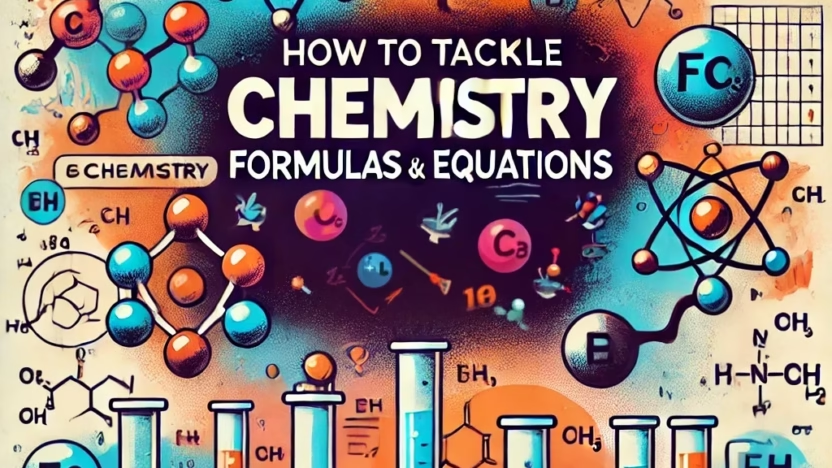Chemistry formulas and equations are the backbone of understanding chemical reactions and processes. Whether you’re a high school student, college learner, or professional brushing up on basics, mastering chemistry formulas requires strategic study and practice. This guide provides actionable tips and insights to help you become proficient in solving and understanding chemistry equations like a pro.
Table of Contents
- Why Chemistry Formulas Matter
- Key Types of Chemistry Formulas
- Techniques for Tackling Chemistry Formulas
- Effective Study Strategies
- Overcoming Common Challenges
- Recommended Resources
- Conclusion
Why Chemistry Formulas Matter
Chemistry formulas and equations are essential for:
- Understanding Reactions: They describe how substances interact and transform.
- Quantitative Analysis: Equations enable calculation of reactants and products.
- Problem-Solving: They provide tools to tackle practical and theoretical chemical problems.
- Exam Success: Mastery of formulas is often crucial for high academic performance.
Key Types of Chemistry Formulas
- Empirical Formulas: Represent the simplest whole-number ratio of atoms in a compound.
- Molecular Formulas: Indicate the exact number of each type of atom in a molecule.
- Chemical Equations: Represent chemical reactions with reactants and products.
- Stoichiometric Equations: Balance equations to reflect the law of conservation of mass.
- Ionic Equations: Show the breakdown of ionic compounds in aqueous solutions.
Techniques for Tackling Chemistry Formulas
1. Master the Basics
Before diving into complex equations, ensure you understand foundational concepts:
- Periodic Table: Learn element symbols, atomic numbers, and valency.
- Chemical Nomenclature: Familiarize yourself with naming conventions for compounds.
- Units and Measurements: Understand moles, molarity, and standard units.
2. Balance Chemical Equations Systematically
Balancing equations is a critical skill in chemistry. Follow these steps:
- Write the Unbalanced Equation: Start with correct formulas for all reactants and products.
- Count Atoms: Ensure the same number of each atom appears on both sides.
- Use Coefficients: Adjust coefficients to balance the equation without altering subscripts.
- Check Your Work: Confirm atom counts and ensure total charge balance.
Example: Balance the equation: H2+O2→H2OH_2 + O_2 \rightarrow H_2O
- Unbalanced: H2+O2→H2OH_2 + O_2 \rightarrow H_2O
- Balanced: 2H2+O2→2H2O2H_2 + O_2 \rightarrow 2H_2O
3. Practice Stoichiometry
Stoichiometry involves quantitative relationships in chemical reactions. To excel:
- Understand Mole Ratios: Derived from balanced equations.
- Perform Dimensional Analysis: Use units to guide calculations.
- Solve Limiting Reagent Problems: Identify the reactant that limits product formation.
Example Problem: Calculate the mass of H2OH_2O formed when 2 moles of H2H_2 react with excess O2O_2:
- Balanced Equation: 2H2+O2→2H2O2H_2 + O_2 \rightarrow 2H_2O
- Mole Ratio: 2H2:2H2O2H_2 : 2H_2O
- Calculation: 2 moles H2×18 g/mol=36 g H2O2 \, \text{moles} \, H_2 \times 18 \, \text{g/mol} = 36 \, \text{g} \, H_2O
4. Use Dimensional Analysis
Dimensional analysis simplifies complex conversions. For example:
- Convert grams to moles using molar mass.
- Determine volumes of gases using the ideal gas law.
Example: Convert 10 g of NaClNaCl to moles:
- Molar Mass of NaCl=58.44 g/molNaCl = 58.44 \, \text{g/mol}
- Calculation: 10 g÷58.44 g/mol=0.171 mol10 \, \text{g} \div 58.44 \, \text{g/mol} = 0.171 \, \text{mol}
5. Leverage Technology
- Equation Balancers: Tools like Wolfram Alpha or ChemCollective.
- Simulation Software: Use PhET Interactive Simulations for visualizing reactions.
- Apps: Try Chemistry apps like Molecules or Periodic Table Explorer.
Effective Study Strategies
1. Practice Regularly
- Work on problem sets and past exam questions.
- Practice balancing equations daily to build fluency.
2. Visualize Concepts
- Use molecular models to understand structures.
- Watch videos explaining reaction mechanisms.
3. Memorize Common Patterns
- Learn solubility rules and common reaction types (e.g., synthesis, decomposition).
- Familiarize yourself with key formulas like the ideal gas law ( PV=nRTPV = nRT ).
4. Study in Groups
- Collaborate to solve challenging problems.
- Teach peers to solidify your understanding.
Overcoming Common Challenges
Confusion with Balancing Equations
- Break the equation into smaller parts.
- Focus on one element at a time.
Struggles with Memorization
- Create flashcards for compounds and reactions.
- Use mnemonic devices (e.g., “OIL RIG” for oxidation and reduction).
Time Management
- Allocate specific times for practice and review.
- Avoid last-minute cramming by preparing consistently.
Recommended Resources
- Textbooks: General Chemistry by Linus Pauling; Chemistry: The Central Science by Brown et al.
- Online Platforms: Khan Academy, Chemguide.
- Mobile Apps: Periodic Table, Balancing Equations Calculator.
Conclusion
Mastering chemistry formulas and equations is a process of understanding, practice, and application. By building a strong foundation, practicing regularly, and leveraging technology, you can tackle chemistry like a pro. Start applying these strategies today, and watch your confidence and skills in chemistry soar!




